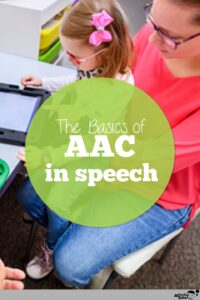
What is AAC?
AAC stands for “alternative or augmentative forms of communication”. According to the American Speech-Language-Hearing Association, AAC is all the ways a person communicates besides speaking verbally. AAC encourages greater independence, increased communication, and more social interactions for many individuals.
When a little one isn’t talking, it’s not uncommon for a therapist to suggest a form of communication other than talking. This doesn’t mean they’ve given up! Or that talking is no longer a priority!
The most important goal is to give our children LANGUAGE. Once they understand language is a way to communicate with others, and have a method that works, they are better equipped to use their voice.
Different types of AAC
There are many types of AAC: no-tech, low-tech, and high-tech. The most common forms of AAC for preschool and elementary populations include signs, picture exchange, or technology/devices.
No-tech
- Gestures
- Facial expressions
- Signs
Low-tech
- Paper and pencil for writing or drawing
- A letter board for spelling words
- Picture exchange system
- Pointing to pictures to express thoughts and needs
High-tech
- A speech generating device (usually a tablet or computer) that “speaks” the user’s selected message through various apps or software programs
Examples:
Main Concerns about AAC
Using Verbal Speech
Are we giving up on my child speaking? If they use AAC, will they choose not to talk?
The short answer is– No! Using AAC will not decrease the likelihood, quality, or possibility of speech.
According to research by Leslie Baker-Ramos in 2017, the use of gestures and signs helps expand expressive language abilities.
Another study performed in 2006 by Diane C. Millar and her colleagues found that the use of AAC does not inhibit speech production but actually supports future speech production.
Giving late talkers or non-speaking students the opportunity to communicate in an alternative way encourages more communication attempts as they gain confidence in themselves.
Not only can people learn how to speak verbally while using AAC systems, but they can also learn to read and write! The possibilities are truly endless.
Age
Is my child too young for this?
AAC is appropriate for people of all ages (toddlers to senior adults!) if they have difficulties speaking or with language skills. Some people use AAC only temporarily while developing their verbal speech or after a procedure while others use it in some form for their entire life.
There are no particular cognitive skills, test scores, or other developmental milestones that must be met before AAC can be introduced.
Choosing the Right One
There are so many options. Some are expensive. How will we choose the right one for my child?
Not every type of AAC works well for every child. An SLP will work with you and your child to determine what type of AAC system works best to meet your child’s communication needs. They will likely trial several different types and then train you and your child how to use the selected AAC to the fullest capability.
An SLP can also work with other professionals like occupational therapists, physical therapists, and teachers of students with visual impairments to ensure that the chosen AAC works best for your child’s individual needs.
Insurance also covers some high-tech AAC, so that can be factored into considerations when selecting the right one for your child.
Other questions beyond the basics of AAC?
When considering AAC, always talk to an SLP. It’s even better to seek out an SLP who specializes in AAC when working with a niche like this. Anne at Beautiful Speech Life is a wealth of information for the basics of AAC and beyond!
Resources
“Gesture and Signing in Support of Expressive Language Development” by Leslie K. Baker-Ramos in Inquiry in Education, 2017, Vol. 9: Iss. 2, Article 2. Retrieved from: https://digitalcommons.nl.edu/ie/vol9/iss2/2
“The Impact of Augmentative and Alternative Communication Intervention on the Speech Production of Individuals With Developmental Disabilities: A Research Review” by Diane C. Millar, Janice C. Light and Ralf W. Schlosser in Journal of Speech, Language, and Hearing Research, April 2006, Vol. 49, 248-264. doi:10.1044/1092-4388(2006/021)





